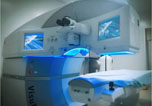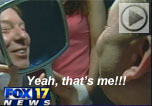Chapter Seven
The LASIK Procedure:
What to Expect
What to Expect
On the day of the procedure, you should arrive at the laser
center as rested and relaxed as possible. You should
probably allow about a two to three hour stay at the laser
center. This may vary from center to center. Wear comfortable
clothing. Do not wear makeup, perfume, or cologne on the day
of your laser surgery. These things may interfere with the
cleanliness of the procedure and the function of the excimer laser.
You should not wear contact lenses following your
preoperative LASIK consultation unless it will be some time
before your scheduled surgery. Soft lenses need to be out at least
three days prior to surgery, and gas permeable or hard lenses
need to be out for three weeks prior to surgery. It is essential that
your eye be in its most natural state at the time of surgery.
With LASIK, a mild oral sedative may be administered
before the procedure begins, but it is not usually necessary.
During the procedure, your surgeon will constantly be talking to
you. He or she will talk you through the entire procedure; you
will know at all times what to expect. There will be no surprises
and no pain.
Because LASIK is more surgical in nature than PRK,
sterile surgical conditions must be maintained. Your face will be
cleaned with a disinfectant, and you will be asked to wear a
surgical cap. You will be given an antibiotic drop and possibly
an anti- inflammatory drop. These may sting. You will then be
taken to the laser suite, positioned under the excimer laser, and
given numbing drops. Your eyelashes will be taped out of the
way, and an eyelid holder will be placed between your eyelids
to keep you from blinking. This eye speculum can sometimes
cause mild pressure or discomfort on your eyelids.
A suction ring is used to hold your eye in position and
maintain pressure within the eye while the corneal flap is being
made. This flap varies between 130 to 180 microns in thickness.
The usual thickness is 160 to 180 microns, but your surgeon may
choose an alternate value, depending on the thickness of your
cornea and your refraction. This flap represents about thirty
percent of the thickness of the cornea, which is usually around
550 microns (about half a millimeter).
You will not see or feel anything while the flap is made,
but the environmental lighting will disappear during that time.
You may also feel a little pressure sensation. The whole process
takes around thirty seconds.
When the flap is lifted back, your vision will get blurry.
You will be asked to fix your vision on a target light (usually
red, green, or yellow). The laser part of the procedure is then
performed, taking twenty to ninety seconds. This portion of the
procedure is painless, but you may notice a faint odor as the laser
photoablation proceeds. You will also hear a clicking or buzzing
sound with each pulse of the laser.
During the laser procedure the light will move, become
a blur, or disappear. Your job will be to continue to look straight
ahead at the fixation light. If your eye does start to wander, the
laser will stop instantly, you will be coached to fix again on the
target, and the laser procedure will resume. Some surgeons use
a fixation ring to assist in the fixation of the eye, which may help
to improve the accuracy of the ablation. The ring is left on the
eye at very low pressure while the laser is firing. The surgeon
utilizes this tool to control the position of your eye and prevent
your eye from looking away from the fixation light. This ensures
that the laser energy is focused precisely on the center of the
cornea during the entire procedure.
After the laser treatment is completed, the hinged flap is
then placed back into its original position, and the surgeon waits
one to five minutes for the eye to create a natural vacuum to hold
the flap down. (The cornea has the unique ability to seal itself
back into place as if no flap had ever been made.)
After the drying is completed, the lid holder is removed
and you are able to blink normally. While a bandage contact lens
is not required, some patients will receive one to aid in their
individual healing process.
A newly created corneal flap is held down by four forces:
- Tissues like to stick together, and within seconds
hydrostatic forces between the flap and the corneal
stroma create a seal between the two tissues, causing
the flap to begin to readhere to the cornea.
- The endothelial cells (inner lining of the cornea) are
constantly pumping fluid out of the eye to maintain
corneal clarity. This pump function creates a natural
vacuum that holds the flap down. This process begins
working in a matter of minutes.
- Within hours the epithelial cells grow over the edge
of the flap, helping to glue it down. This process
takes a few days to complete.
- Eventually, the internal healing process allows the
flap to be permanently glued down. This occurs over
a few months.
With LASIK, the top surface of the cornea (epithelium)
and the next layer (Bowman's layer) are preserved (see illustration on page 22). This is the reason the recovery time is shorter
than with PRK.
A typical LASIK procedure takes between ten to fifteen
minutes per eye. Because of the rapid visual recovery experienced
by most LASIK patients, both eyes may undergo the procedure
on the same day if your surgeon has attained that level of
expertise and both of you are comfortable with the decision.
Some surgeons only perform eyes on separate days to reduce risk
or improve precision. Again, this is a patient decision to be made
after appropriate consultation.

Photograph of patient under an excimer laser
Contemplating LASIK?
Marilyn was serious about having LASIK vision
correction performed on her eyes. She had this to say when asked
about the experience:
"When I arrived at the doctor's office, a medical assistant
took me to a prep room, gave five milligrams of Valium (which
relaxed me), and administered anesthetic eye drops. 'You're all
set to go,' she told me.
"I was then taken to the laser room where I laid down
on a reclining chair under the laser and had my eye taped open
with plastic drapes. The surgeon explained each step of the
procedure as he went along.
"First, he used the microkeratome to lift up a thin,
cellophane-like, outer layer of the cornea (called the corneal flap)
and folded it back so that the inner cornea was directly exposed.
As soon as the corneal flap was lifted, everything looked
extremely blurry. Then, in the course of about twenty seconds,
ultraviolet light from the excimer laser reshaped the internal
cornea. I could hear the laser clicking, but I felt nothing.
"Finally, he folded the corneal flap back into place.
'Everything went great,' he reported. Then he proceeded to
perform the procedure on the other eye.
"Immediately after the procedure, my vision was a bit
blurry and my eyes a bit scratchy, but I felt no pain nor any real
discomfort. I had protective plastic shields placed on my eyes at
the conclusion of the operation so I wouldn't rub my eyes.
"The next morning the doctor removed my eye shields
and I could see 20/20 out of each eye. I now have the freedom
to work, play, and ski without the bother of glasses and contact
lenses. I trust my surgeon's judgment and skill and continue to
recommend him to everyone I know who is interested in the
procedure.
"P.S. I was a very tough patient! Not only am I a
physician, I am also married to an ophthalmologist." --Marilyn K
Pros and Cons of LASIK
Pros
- Low incidence of postoperative pain
- Fast recovery
- Higher accuracy for higher degrees of correction
- Low probability of serious postoperative haze
- Ability to perform surgery to both eyes on the same day
- On medicated eye drops only five to seven days
- Architecture of cornea stays intact
Con
- Possibility of flap complications
| 




















